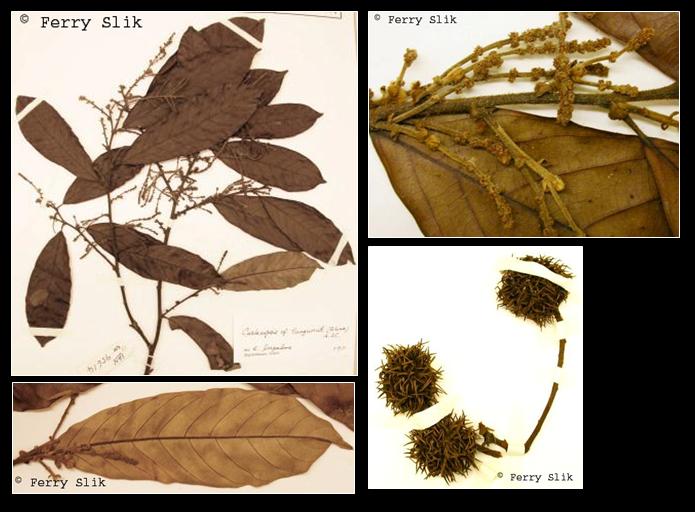Castanopsis tungurrut (Blume) A.DC., J. Bot. 1 (1863)
Latin for the local name of this species.Synonyms
Castanea tungurrut Blume
Castanea tungurrut forma sumatrana Miq.
Castanopsis conspersispina Merr.
Castanopsis ridleyi Gamble
Diagnostics
Tree with rough fissured bark. Stipules boat-shaped, ca. 5 mm long. Petiole up to c. 1.5 cm long.
Leaves alternate, simple, up to 15 by 6 cm, penni-veined (11-19 secondary veins), lower surface
whitish. Male flowers ca. 1.5 mm diameter, yellowish, placed in racemes. Fruits ca. 30 mm long,
green-reddish, nut completely enclosed by spiny cupule, non- or iregularly splitting, spines up to
23 mm long.
Description
Tree, 20-37 m by 92 cm diameter; bark rough, fissured. Branchlets initially with fulvous tomentum, later
glabrescent, rather sturdy, dull greyish black, smooth, sparsely lenticellate; terminal bud ovoid-
ellipsoid, 3-5 by 2-3 mm, scales ovate, elliptic, acute, 3-4 by 2 mm. Stipules boat-shaped, ovate-
triangular, 4-6 by 2-3 mm. Leaves (8-)12-15(-23) by (3.5-)5-6(-9) cm (index 2-3), widest about the
middle to slightly below; base rounded-acute, sometimes asymmetrical, top tapering and subacuminate;
more or less discolorous, above rather glossy, green-brownish, glabrous, beneath dull
with a faint greyish tinge, densely covered with a waxy mass in which stellate scales are very closely
adpressed (magnification 60!), and also with some longer hairs (the latter in Sumatra almost wanting);
midrib prominent on both surfaces, stronger beneath; nerves 11-19 pairs at an angle of 60-70 degrees
parallel, arcuating and disappearing near the margin, prominent beneath, flattish above; reticulation
fine, dense, scalariform, sometimes obscure above; petiole (0.5-)1-1.5(-2) cm, adaxially flat
or shallowly sulcate. Inflorescences male, female, or androgynous. Male rachis 10-25 cm by 1-2 mm;
bracts and bracteoles ovate-acute, 2-3 by 1-1.5 mm, hairy outside; male flowers in clusters of 3,
perianth deeply incised, lobes 5-6, acute. 2-2.5 by 1-1.5 mm, hairy on both sides, stamens 10-12,
filaments 3-4 mm, anthers 0.2-0.25 mm long, pistillode 1.5 mm diameter. Female or androgynous rachis
5-15 cm, bracts thick-coriaceous, ovate-acute, 2-2.5 mm, densely hairy outside; female flowers solitary,
perianth lobes 5-6, acute, 0.7-1 mm, densely hairy, staminodes 12, rudimentary, styles 3, conical,
recurved, 2-2.5 mm. Young cupule sessile, ovoid, on the rounded lateral sides with spine-like tubercles,
on the flat median sides scaly. Ripe cupule subsessile, obovoid-ellipsoid, 5-6 by 3-4 cm; wall
1-2 mm thick, covered partly with fulvous puberulence, and mostly all over with scattered bundles
of slender spines branched in the basal half and easily reflexed 10-23 mm long, sparsely puberulous;
dehiscence none or irregular. Fruit solitary, ovoidellipsoid, 3-4 by 1.5-2 cm, wall 1 mm thick,
completely adnate to the cupule, when ripe rugose and glabrous; cotyledons flat-convex. [from Flora
Malesiana]
Ecology
In undisturbed mixed dipterocarp forests up to 1500 m altitude. In swamps, along rivers
and on hillsides.
Distribution
Peninsular Malaysia, Sumatra, Java, Borneo.
Local names
Borneo: Barangan.
Sumatra: Kalimorot, Tungereut.
